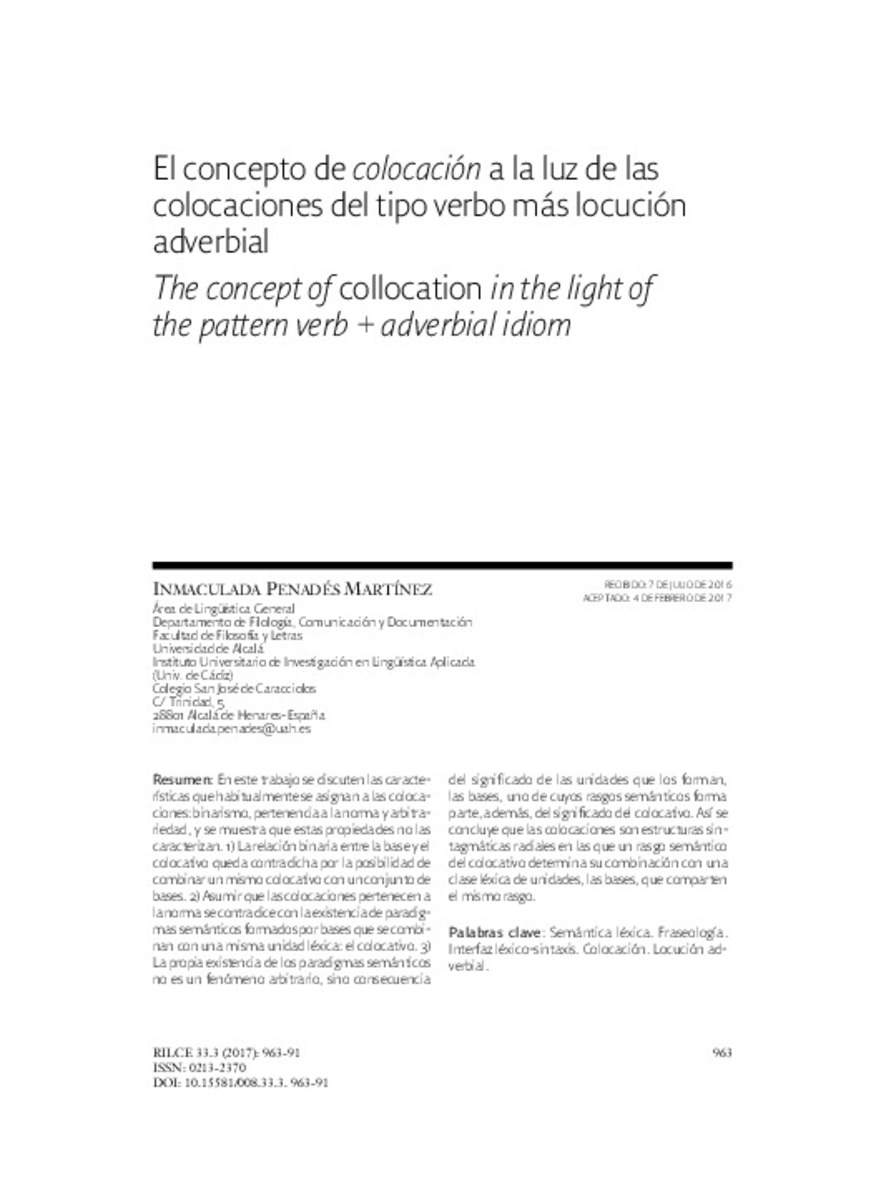Full metadata record
| DC Field | Value | Language |
|---|---|---|
| dc.creator | Penadés-Martínez, I. (Inmaculada) | - |
| dc.date.accessioned | 2018-06-11T10:22:31Z | - |
| dc.date.available | 2018-06-11T10:22:31Z | - |
| dc.date.issued | 2017 | - |
| dc.identifier.citation | Penadés-Martínez, I. (Inmaculada). "El concepto de colocación a la luz de las colocaciones del tipo verbo más locución adverbial". Rilce. Revista de Filología Hispánica. 33 (3), 2017, 963 - 91 | es |
| dc.identifier.issn | 0213-2370 | - |
| dc.identifier.uri | https://hdl.handle.net/10171/53111 | - |
| dc.description.abstract | En este trabajo se discuten las características que habitualmente se asignan a las colocaciones: binarismo, pertenencia a la norma y arbitrariedad, y se muestra que estas propiedades no las caracterizan. 1) La relación binaria entre la base y el colocativo queda contradicha por la posibilidad de combinar un mismo colocativo con un conjunto de bases. 2) Asumir que las colocaciones pertenecen a la norma se contradice con la existencia de paradigmas semánticos formados por bases que se combinan con una misma unidad léxica: el colocativo. 3) La propia existencia de los paradigmas semánticos no es un fenómeno arbitrario, sino consecuencia del significado de las unidades que los forman, las bases, uno de cuyos rasgos semánticos forma parte, además, del significado del colocativo. Así se concluye que las colocaciones son estructuras sintagmáticas radiales en las que un rasgo semántico del colocativo determina su combinación con una clase léxica de unidades, las bases, que comparten el mismo rasgo. | - |
| dc.description.abstract | In this paper we discuss the characteristics that are habitually assigned to collocations: binarism, belonging to the norm and arbitrariness and show that these properties do not in fact define them. 1) The binary relationship between the base and the collocate is contradicted by the possibility of combining the same collocate with a number of bases. 2) The assumption that collocations belong to the norm is refuted by the existence of semantic paradigms formed by bases which combine with the same lexical unit: the collocate. 3) The very existence of semantic paradigms is not an arbitrary phenomenon, but rather, a consequence of the meaning of the units that constitute them, the bases, one of whose semantic features forms part of the meaning of the collocate. Thus, we can conclude that collocations are radial syntagmatic structures in which one semantic feature of the collocate determines its combination with a lexical class of units, bases, which share the same feature. | - |
| dc.language.iso | spa | - |
| dc.publisher | Servicio de Publicaciones de la Universidad de Navarra | - |
| dc.rights | info:eu-repo/semantics/openAccess | - |
| dc.subject | Semántica léxica | - |
| dc.subject | Fraseología | - |
| dc.subject | Interfaz léxico-sintaxis | - |
| dc.subject | Colocación | - |
| dc.subject | Locución adverbial | - |
| dc.subject | Lexical semantics | - |
| dc.subject | Phraseology | - |
| dc.subject | Lexical-syntactic interface | - |
| dc.subject | Collocation | - |
| dc.subject | Adverbial idiom | - |
| dc.title | El concepto de colocación a la luz de las colocaciones del tipo verbo más locución adverbial | - |
| dc.title.alternative | The concept of collocation in the light of the pattern verb + adverbial idiom | - |
| dc.type | info:eu-repo/semantics/article | - |
| dc.identifier.doi | 10.15581/008.33.3.963-91 | es_ES |
| dadun.citation.endingPage | 91 | - |
| dadun.citation.number | 3 | - |
| dadun.citation.publicationName | Rilce. Revista de Filología Hispánica | - |
| dadun.citation.startingPage | 963 | - |
| dadun.citation.volume | 33 | - |
| dc.date.updated | 2018-06-11T10:22:31Z | - |
| dc.description.version | Peer Reviewed | - |
Files in This Item:
Statistics and impact
Items in Dadun are protected by copyright, with all rights reserved, unless otherwise indicated.






